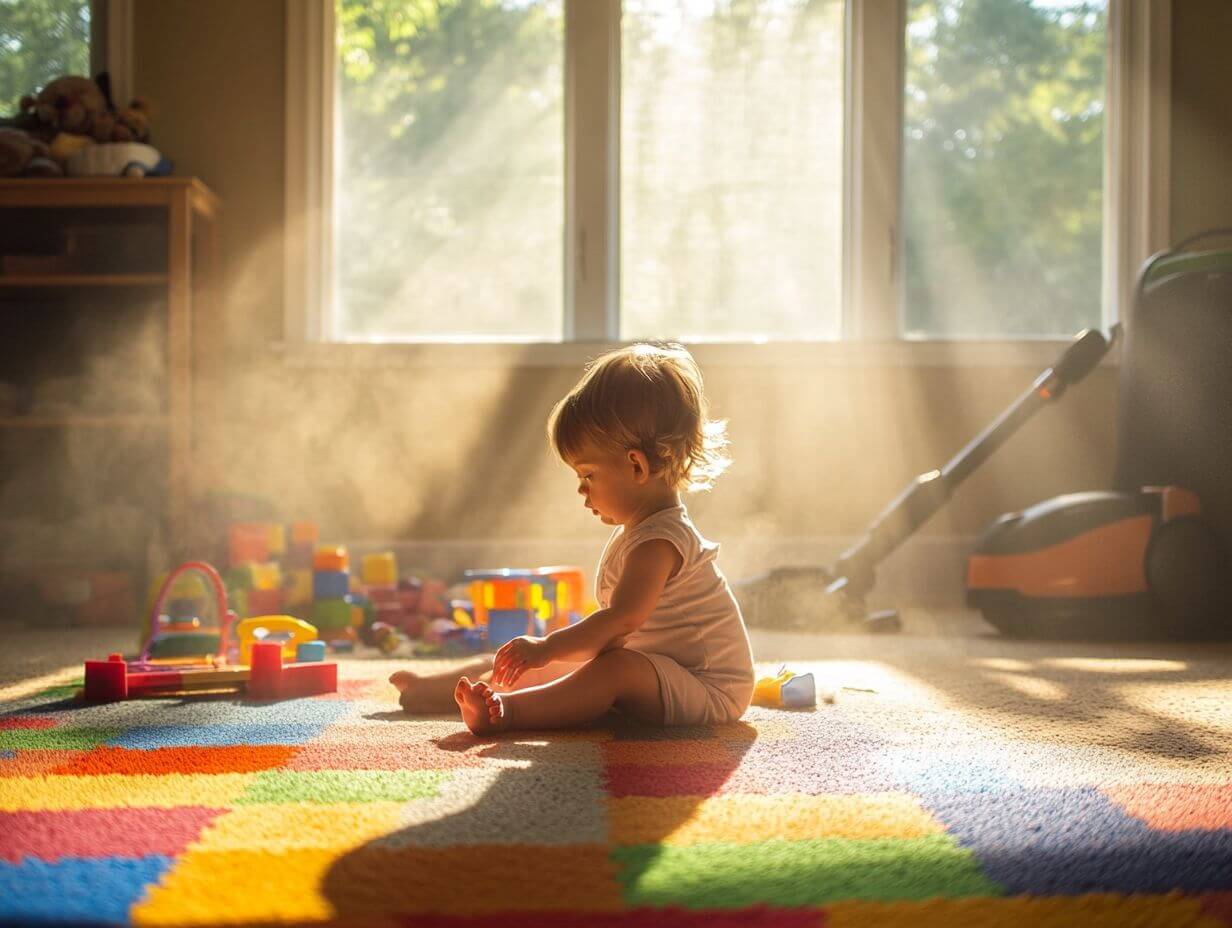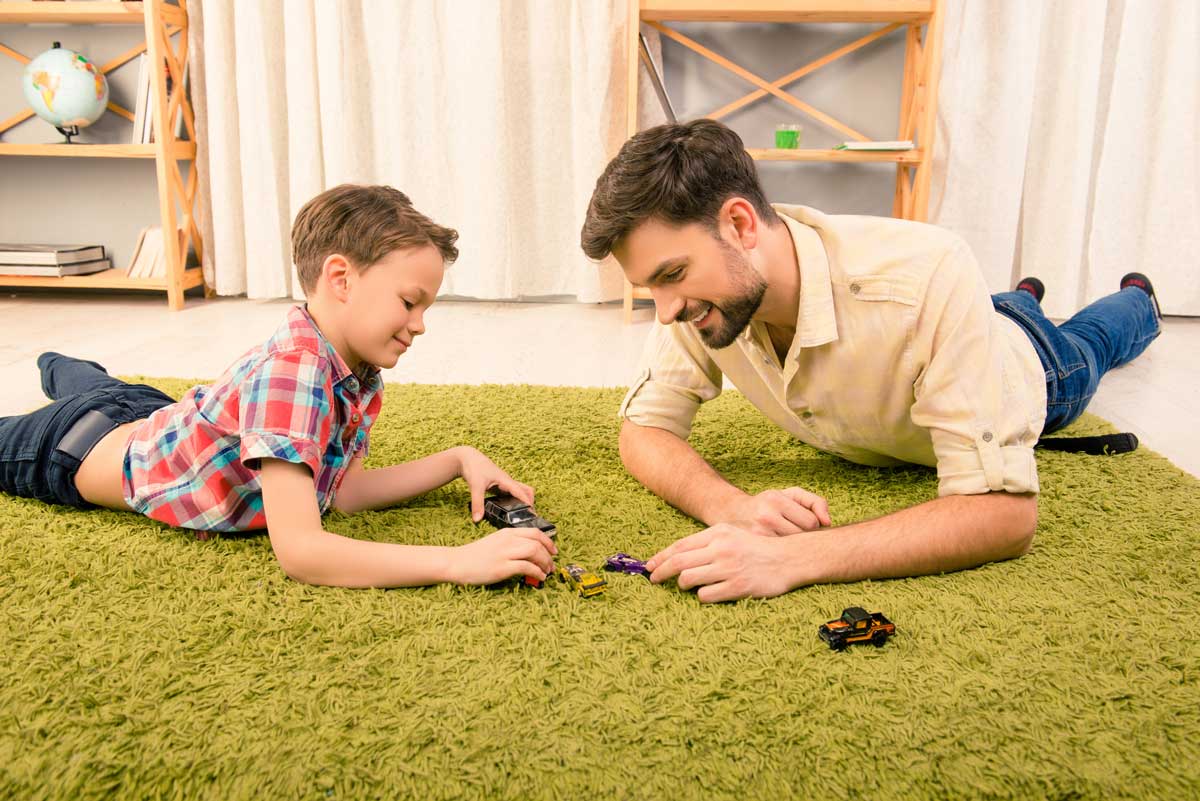G'day, parents of busy little bees! If you've got a little tornado who seems permanently set to "zoom," you're not alone. Many Aussie families find themselves wondering if their energetic ankle-biters will ever find that elusive "off switch." The good news? The secret might be right under your feet—literally! Sensory play rugs are becoming the unsung heroes of calm in homes across Australia, transforming wiggle sessions into wonderful moments of focused play.
The Magic Under Their Toes: How Sensory Rugs Work Wonders
Let's get real about those wiggly kids for a moment. That constant movement isn't just about driving you bonkers (though it might seem that way during your fourth Zoom meeting of the day!). According to Brisbane-based occupational therapist Dr. Emma Thompson, "Children who seek constant movement are often trying to regulate their nervous systems. Their bodies are literally craving sensory input."
That's where a thoughtfully designed textured play mat becomes more than just floor decor—it becomes powerful sensory medicine.
"When children interact with different textures through their most sensitive body parts—hands and feet—they receive intense sensory feedback that helps calm their systems," explains Perth pediatric sensory specialist James Wilson. "It's like scratching an internal itch they didn't know they had."
Creating a Sensory Dream Space: More Than Just a Pretty Rug
Imagine transforming a corner of your living room into a magical sensory haven where your little dynamo actually slows down and engages in focused play. This dream space doesn't require a home renovation or interior designer—just some thoughtful elements centered around the right sensory floor mat.
Sydney mom of three Jasmine Lee shares her experience: "We created what we call the 'chill zone' with our multi-texture rug as the centerpiece. My son, who was diagnosed with sensory processing differences, gravitates there instinctively when he's feeling overwhelmed. The different textures under his feet seem to reset his system better than any words or strategies I could offer."
Elements of a Perfect Sensory Rug Space:
- A quality tactile rug with varied textures (think soft, bumpy, ridged, smooth sections)
- Diffused, calm lighting (harsh overhead lights can overstimulate)
- A few carefully chosen sensory toys that complement rather than overwhelm
- Comfortable seating options like floor cushions or a small bean bag
- Clear visual boundaries that signal "this is a special space"
Melbourne early childhood educator Olivia Chen suggests: "Think of the sensory rug area as a secret garden for their nervous system—a place where everything is designed to help them feel just right in their bodies."
Not Just Calming—Brain-Building! The Science Behind Sensory Rug Play
While the immediate calm that comes from quality sensory rug time might seem like miracle enough for tired parents, the long-term developmental benefits are equally impressive.
"When children engage with varied textures during play, they're building neural pathways that support everything from fine motor skills to emotional regulation," explains Adelaide neuropsychologist Dr. Tom Williams. "The simple act of running fingers over different rug textures creates a sensory-rich experience that literally shapes brain development."
Research from Queensland University's Child Development Center suggests that regular tactile play on varied surfaces can improve:
- Attention span (by 27% in their 2023 study)
- Emotional regulation (children showed faster recovery from upsets)
- Fine motor precision (critical for later writing skills)
- Spatial awareness (understanding where their body is in space)
- Language development (sensory experiences create rich vocabulary opportunities)
"We've seen remarkable improvements in children's ability to sit and focus on other tasks after regular sensory rug play," notes Tasmania-based special education teacher Maya Phillips. "It's as though the sensory input fills their cup, and then they can attend to more cognitive activities without constantly seeking movement."
Sensory Rug Activities That Work Magic on Wiggly Bodies
Want to maximize the calming potential of your texture-rich floor space? These parent-tested activities are both fun and regulatory:
1. Texture Treasure Hunt
Hide small objects under different textured sections of your varied-texture rug and have your child find them using only their sense of touch. This activity is not only calming but also builds fine motor discrimination.
"My daughter would spend ages on our sensory search rug hunting for hidden treasures," shares Brisbane father Sam Thompson. "It's the one activity that consistently helps her transition from high-energy playground mode to focused indoor time."
2. Barefoot Balance Paths
Create "sensory stepping stones" across different textured sections of your rug. Children must stay balanced while describing how each texture feels under their feet.
Gold Coast occupational therapist Aiden Chen explains why this works: "Combining balance challenges with sensory awareness creates a full-body regulating experience. The brain is so busy processing both inputs that it naturally slows other systems down."
3. Texture Tales
Use the different sections of your multi-sensory rug as settings for storytelling. Bumpy sections might be "rocky mountains," while smooth parts become "still lakes."
"My son and I create elaborate stories using our landscape sensory rug as the setting," shares Perth mom Ellie Grant. "He'll move his fingers from texture to texture as the 'character' in our story travels. I've noticed these storytelling sessions have a visible calming effect—his breathing slows, his body settles, and he becomes completely absorbed in our tale."
4. Sensory Breathing Spots
Designate certain textures on your rug as "breathing spots" where children practice deep breathing while feeling the texture with their hands or feet.
"We have special 'calm down spots' on our sensory circle rug," explains Sydney father and mindfulness coach Tim Nelson. "When emotions run high, we have a family routine of finding a texture spot and taking five deep breaths while focusing on the feeling under our fingers. It's simple but remarkably effective."
5. Texture Matching Memory Game
Create pairs of texture swatches that match sections of your rug. Place them face down and play a memory game where children must match the samples to the corresponding rug section.
"This game is brilliant for developing both memory and sensory discrimination," notes Melbourne early learning specialist Nina Patel. "Children are so focused on finding the matches that they don't realize they're also regulating their bodies through the concentrated sensory play."
Real Families, Real Transformations: Sensory Rug Success Stories
The After-School Meltdown Solution
"School days were always a nightmare," confesses Adelaide mother Jessica Wong. "My son would come home completely dysregulated—crying, arguing, unable to settle into any activity. Our calming sensory rug has become his after-school reset button. He now heads straight for it, lies down to feel the different textures, and within 10 minutes, he's a different child—calm, regulated, and ready to engage."
The Sensory Seeker Who Found His Match
Canberra parents Alex and Mia Lee struggled with their toddler's constant movement: "Mason never stopped—climbing, jumping, crashing, running. It was exhausting and concerning. Our pediatrician suggested a designated sensory area centered around a high-quality textured play rug. The transformation has been remarkable. He still needs lots of movement, but now he has a place where that movement becomes focused and purposeful rather than chaotic."
The Nighttime Routine Revolution
"Bedtime was our family battlefield," shares Brisbane mother of twins Sarah Johnson. "Until we created our pre-bed sensory routine centered around our evening calm rug. Now the kids know that after bath time, we spend 15 minutes on the sensory rug doing gentle texture activities. It's like magic—their bodies visibly settle, voices get quieter, and the transition to sleep has become so much smoother."
Creating Your Own Sensory Rug Paradise: Expert Tips
Ready to transform a corner of your home into a sensory haven? Here's how to get it right:
Choose Quality Over Quantity
"Many parents make the mistake of creating overstimulating sensory spaces with too many elements," cautions Sydney sensory integration specialist Dr. Lily Chen. "A high-quality multi-texture rug with 3-5 distinct textures is far more effective than a space with dozens of sensory toys but a basic floor surface."
Consider Your Child's Specific Sensory Profile
Not all sensory-seeking children are the same. Some crave deep pressure, others respond to light touch, and some need both at different times.
"Observe which textures your child gravitates toward naturally," suggests Perth pediatric occupational therapist Zoe Williams. "If they constantly seek soft, fuzzy surfaces, a plush sensory rug with varied pile heights might be perfect. If they prefer firmer feedback, look for rugs with more pronounced texture variations."
Create Clear Boundaries
A successful sensory space has defined boundaries that signal "this is a special place with special expectations."
"We outlined our sensory zone rug with battery-operated LED light strips," shares creative Hobart dad James Parker. "This visual boundary helps our daughter understand that when she's in that space, it's time for calm sensory play rather than rough-and-tumble activities."
Pair with Complementary Sensory Tools
While the rug forms the foundation, thoughtfully chosen accessories enhance the experience.
"We keep a small basket next to our texture rug with complementary sensory tools," explains Melbourne mom and sensory space designer Emma Thompson. "A few favorites include a soft brush for texture tracing, weighted stuffed animals for deep pressure, and textured balls for hand manipulation. The key is keeping it simple—too many options can defeat the calming purpose."
Beyond Calm: How Sensory Rugs Spark Imagination
While we've focused on the regulatory benefits of sensory rugs, their impact on creative play and imagination deserves equal attention.
"There's a fascinating relationship between sensory regulation and creativity," notes Queensland early childhood researcher Dr. Sam Johnson. "When children feel regulated in their bodies, their imaginative play actually becomes richer and more complex. The sensory rug provides both the regulatory input and the defined stage for this creativity to unfold."
Darwin mother Olivia King has observed this firsthand: "Our fantasy world sensory rug has different textures built into different 'zones' of the imaginary landscape. I've noticed that my daughter's storytelling becomes incredibly detailed when she's engaged with the varied textures. She'll create elaborate scenarios about fuzzy forest creatures living in the soft section or scaly dragons in the rougher textured areas."
The Bottom Line: Simple Solution, Profound Impact
In a world where parents are bombarded with complex solutions to childhood challenges, there's something beautifully simple about the power of a well-designed sensory rug.
"Sometimes the most effective interventions aren't the most complicated or expensive," reminds Tasmania-based child psychologist Dr. Michael Chen. "The humble sensory rug works because it addresses a fundamental need—children's bodies crave sensory input to feel regulated and safe."
For parents of wiggly, wound-up kids, this texture-rich floor solution might just be the missing piece in your family's puzzle. As Canberra mother of three Lisa Wong puts it: "Our sensory rug isn't just a piece of floor covering—it's become our family's calm center, the place where wiggles turn to wonder and chaos transforms into creativity."
So if you're tired of constant movement, struggling with transitions, or simply wish your energetic little one could find moments of focused calm, consider creating a sensory rug haven in your home. That magical space where little fingers and toes connect with varied textures might just become the most valuable square meters in your entire house—measured not in property value, but in peaceful moments and developmental gold.
After all, in the journey of raising children, sometimes the path to calm runs right through a special rug that speaks directly to their busy bodies and brilliant minds.








Leave a comment
This site is protected by hCaptcha and the hCaptcha Privacy Policy and Terms of Service apply.